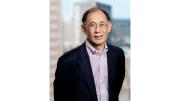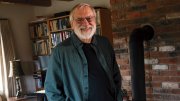During a wide-ranging, reflective conversation at Massachusetts Hall on the morning of May 11, just weeks before the conclusion of his 12-year Harvard Corporation tenure on June 30, senior fellow William F. Lee took stock of the 2010 governance reforms, the state of the institution from the governing-board perspective, and current University challenges and opportunities. Among the latter, he touched on issues ranging from interdisciplinary research and Allston development to reconciling perceived tensions between diversity and inclusion and freedom of speech and thought.
That the meeting could take place in person—as landscapers spruced up the turf in Harvard Yard, and the tent poles for the Commencement platform awaited installation in Tercentenary Theatre—indicated that after two-plus years of pandemic precautions, the end of Lee’s service coincides with a period of welcome near-normalcy. Given his service as an Overseer from 2002 to 2008 (during what became a Harvard leadership crisis and unexpected presidential search, followed by the financial meltdown) and then as a Corporation member during the governance reforms prompted by those traumas, the relative calm now suggests the efficacy of the reforms in Harvard governance and management. No current University leader has been more deeply, continuously involved in conceiving and effecting those changes than Lee.
University Governance, Reformed
Lee pointed to the governance reforms unveiled in late 2010—a Corporation enlarged to 13 members, with expert committees on core fiduciary responsibilities such as finances and capital facilities, term limits, and an elected senior fellow—as “one of the things that I feel best about” after 18 years of governing-board experience.
“We’ve put in place a series of committees, protocols, and procedures on issues like finances, facilities, and broader strategic issues” that have enabled the Corporation, he said, to approach those core responsibilities “on a disciplined basis.” Across the University and its separate schools, he continued, the strengthened governance processes (in harness with changes in management under the president, provost, and executive vice president) have resulted in “better planning for Harvard, better implementation for Harvard,” and enhanced capacity to focus on larger, key issues.
Term limits—fellows are now elected for a six-year term, and can, following a review of their performance, be elected for a second one—have had the effect of “constantly refreshing and replenishing the members of the Corporation,” Lee said. Fellows now serve at their best, and recently elected members “constantly bring in…new perspectives.”
Their expertise—already broadened in comparison to the prior seven-member Corporation—is further supplemented by the “enormously helpful” perspective contributed by committee appointees who are not members of the governing boards: experts in finance, say, or capital projects and planning.
In combination, Lee said, these changes enable the Corporation today to bring multiple talents and perspectives to bear on both “key long-term strategic issues for the University,” the board’s most important role, and “the issues of the day”—like the response to COVID-19. During the pandemic, he said, Corporation members were in constant contact with President Lawrence S. Bacow, Provost Alan M. Garber, and Executive Vice President Katie Lapp (who just announced she is stepping down from her responsibilities), while maintaining their focus on strategic imperatives.
That said, Lee noted that there was “no possibility” that the changes set in motion in 2010 could be “perfect or complete.” After he became senior fellow in 2014, the Corporation undertook a five-year review of the reforms, and has continuously introduced further changes and refinements. For instance, all members now undergo that “really comprehensive review of their performance” at the end of an initial term (Lee was the first to be reviewed; the review is performed by fellows other than the senior fellow), before they can be considered for a second term. The reviews, he said, are a useful source of insight into each member’s performance and the operation of the Corporation as a whole. And he said an idea that came to him casually—pairing each fellow with a dean or head of an academic unit for a year, and rotating them annually—had proved to be a huge benefit. The Corporation acquired much deeper, broader information on the schools, and the personal relationships that developed were of great value in informing the board’s deliberations and, presumably, speeding decisions. Those relationships also provide a channel of information that Harvard’s presidents might not hear directly—an outcome, Lee said, that both Bacow and Drew Gilpin Faust (who undertook the reforms) have welcomed.
Core Priorities
Lee was asked what work remains undone from the 2010 reforms, and the most significant challenges and opportunities before Harvard today.
He framed the Corporation’s essential role as ensuring that 50 years hence, “Harvard is the same robust institution and community, with the same preeminent reputation” that it enjoys today. Accordingly, the decisions being made today and in future years are part of a continuous process of exercising fiduciary responsibility for the University.
He identified three substantive matters of overarching importance, the first stemming from his experience (which will continue this fall in argument before the Supreme Court of the United States) as counsel defending the University in the Students for Fair Admissions litigation (SFFA) challenging affirmative action (the consideration of race) in College admissions processes. “There is a sense,” Lee said, “and I think that it is incorrect, that the principles of diversity, equity, and inclusion, and the principles of free speech” are in conflict. In fact, they work together, and must be made to do so not only within Harvard, but in society at large, and indeed globally. “The manner in which institutions like Harvard address issues of diversity, equity, and inclusion, and free speech and free thought, [which] can all be pursued robustly on campus, are a challenge and an opportunity”—one that the Corporation sees very clearly, he emphasized.
A second opportunity stems from the fact that “Harvard exists today in the most robust life-science community in the world,” encompassing the medical and public-health schools, MIT, the hospitals, other universities, and local research institutes. Lee said that is “an extraordinary opportunity to bring together all of this talent, all of this institutional potential, in a way that benefits us nationally, globally, and, derivatively, institutionally.”
And third, enabling the development of Allston to proceed “remains a major opportunity” on which the University is making progress, he maintained. “It is a wonderful opportunity for Harvard, but it also needs to be a wonderful opportunity for the people who live in it,” who have expressed concern recently about the scale, scope, and larger plans for development in coming years. Lee pointed to the science and engineering complex, the planned American Repertory Theater facility, and the planned University conference center within the commercial “enterprise research campus” as clear benefits, delivered or in the offing. “[If] done correctly,” he continued, the larger development “benefits the broader Allston community and not just the Harvard community, and we clearly understand that.”
The Corporation and the Campus Community
Lee was asked about the tangible effects of the governance reforms on the University, not just within the confines of Loeb House, where the governing boards meet. He cited three.
•Daily operations. The changed membership, structure, and processes, he said, “created the institutional foundation for dealing with the day-to-day leadership and management of a $5-billion institution.” With more members, more expertise, and permanent committees versed in Harvard finances and other matters, Lee said the Corporation can address the issues that inevitably arise unpredictably, so the members and University leadership—the president, provost, executive vice president, and their staffs—can attend to their separate roles of governance and management without being in a state of permanent crisis.
As an example, he cited the work of Thomas Hollister, vice president for finance and chief financial officer, in pushing for recession planning during the boom times several years ago when, as Lee put it, it seemed “every tree would grow to the sky, and every fundraising request would result in a billion-dollar gift.” That work prepared the Corporation, the central administration, and the schools for the financial crisis that seemed apparent at the beginning of the pandemic in early 2020—a far better response than the straitened circumstances that arose in 2008-2009. (This is one part of the larger reinforcement of financial planning and control capabilities put in place in the central administration in the wake of the financial crisis, and now synched up with similar enhancements of Corporation oversight and expertise.)
Similarly, he said, one- and five-year planning for capital projects results in more comprehensive understanding of the University’s overall financial plans, and overcomes the prior problem of donor-funded projects being approved with construction financing, but without adequate provision for subsequent operation and maintenance funding.
•One Harvard. The more expert Corporation, he said, was better equipped to “be a mechanism for moving forward with One Harvard”—the internal handle for identifying areas for intellectual collaboration across faculty and staff units. Administratively, Harvard’s senior management has built dotted-line relationships among each school’s development personnel and the University fundraising organization, to better effect planning and outreach to donors. Similarly, separate information-technology organizations now have relationships with the central IT team (one reason the University could pivot to online instruction so quickly in March 2020).
Such administrative bridges touch on Corporation concerns in some cases (some fellows are more regularly involved in high-level fundraising than was the case in the past).
More importantly, Lee observed, the enlarged Corporation, with members having built bridges to each school and dean, was in a position to discuss and share ideas on the University’s recently released report on the legacy of slavery, schools’ differing situations and perspectives, and the coordinated recommendations for action across the institution.
And given the common understandings among fellows, their collective expertise, and their familiarity with schools and their leaders, the Corporation and administration could act literally overnight when, in 2020, the Trump administration proposed to prohibit foreign students from being in residence while enrolled in (pandemic-caused) online-only programs of study—an initiative Harvard and MIT met with a successful legal challenge.
Long-Term and Strategic Issues
Lee identified an array of strategic issues on the Corporation’s radar, beginning with the problem of “how are we going to deal with the cost of education long term and what it will mean to Harvard”—the fundamental responsibility of the University’s fiduciaries.
Among the matters President Bacow and his senior staff are working on, in which the Corporation is interested, Lee listed a variety of areas of “what I would call interdisciplinary work that would bring together the resources and talents of the broader Harvard community” on such subjects as climate change (now being led by James Stock, vice provost for climate and sustainability); artificial intelligence (of which the new Kempner Institute is just one component, he said); the life sciences generally (as discussed above); and “the commitment that Drew made and Larry carried forward to the humanities” when other institutions pivoted more exclusively to the sciences—areas in which Harvard’s humanities expertise has a continuing role to play.
He then turned to other kinds of priorities:
•getting Allston development right for the wider community (as discussed above), while keeping “Cambridge interesting and robust and eclectic,” as it has been for 400 years;
•“the Harvard-MIT relationship,” which Lee described as critical, even as the institutions compete for certain students and faculty members, given the opportunities to build on such collaborations as edX (online learning technology), quantum computing, and the Broad Institute (genomics research), for the good of each and for Boston more broadly; and
•diversity and demographic change in the broadest context. “The face of America is changing, demographically, by race, ethnicity, and gender,” Lee said. “How we adjust to the changing face of the country, of our students, faculty, and staff, is going to be critical to our long-term vibrancy,” especially in light of the political and cultural tensions playing out across the country today.
Fundraising, Governing vs. Managing, and Communications
Lee was asked whether the 2010 broadening of the Corporation’s mission to explicitly include “securing” resources for the University, as opposed to overseeing the use of such resources, had affected its culture or operations. He said, “Honestly, not much.” The fellows include people with diverse experiences, including “some people…who’ve been very involved in helping us build our resources” (such as members Paul Finnegan, treasurer; Timothy Barakett; and senior fellow-elect Penny Pritzker); some who have “enormous experience in education” (such as Amherst president Biddy Martin and former Princeton president Shirley Tilghman); some from the “for-profit world” (Kenneth Chenault, Diana Nelson, David Rubenstein, and Theodore Wells); and some from public service (Tino Cuéllar, Karen Gordon Mills, Pritzker).
That diversity is a strength, Lee said, but the reconstituted Corporation is not so large that its deliberations become shallow or impersonal. Overall, he said, some members “help increase the resources we have,” and “some have a better idea than others about how an academy should deploy those resources.”
One concern in reforms such as those Harvard undertook in 2010: that they not muddy the proper boundaries between governance (the fiduciary oversight assigned to the Corporation) and management and leadership (the responsibility of the president chosen and evaluated by the governing boards). Lee was asked about his own multiple roles at Harvard, and whether that example might pose any problems. Noting that he has taught at Harvard Law School for nearly two decades, he joked that dean John Manning said that Lee worked for him; that he worked for President Bacow; and that Bacow worked for Lee, as senior fellow.
“I’ve been fortunate to have several roles,” Lee said, including his teaching appointment; experience on the governing boards; representation of the University in the affirmative-action litigation; alumnus (he was the first person in his family to attend Harvard); and parent and relative of other Harvard students (there are now 24 Harvard degrees in the family, he said).
“These multiple roles have given me a perspective I wouldn’t have had otherwise,” Lee noted. He said he had constantly distinguished between his governance and fiduciary roles, and daily engagement in managerial ones, like serving as counsel to Harvard in the SFFA lawsuits. His relationships with Faust and Bacow, he noted, took these multiple roles into account, and “They’d let me know if I ever overstepped.” (In the future, though, as the institutional reforms gel and those who put them in place move on from the scene, it is fair to question whether navigating such overlapping roles is too much to ask of anyone, Corporation member or president.)
Lee noted that unlike the president and other officers, the senior fellow has no Harvard office: a symbolic way of underscoring the different realms of governance and leadership. In the meantime, his numerous Harvard roles mean that at a time of transition in what is, after all, a nearly four-century-old institution, “I’ve met an enormous number of people across the University” among the ranks of students, faculty members, and staff, and so can bring valuable perspective to this work. That he has been based in Boston, as is his successor fellow, Tracy Palandjian, is advantageous, Lee said: he was in a better position to engage in the community’s life, as will she, than Corporation members who live farther away.
One explicit goal of the 2010 reforms was to formalize and increase communications between the Corporation and the wider University community, including up to four briefings yearly by the senior fellow. Lee was asked to assess performance relative to that objective.
“Given that the Corporation before the reforms was something akin to the Wizard of Oz behind the curtain” or as secretive as cardinals during “the election of a new pope,” Lee said, he thought progress had been made. During the 2017-2018 presidential search, for instance, the Corporation members as a whole—not just the senior fellow—reached out to the community, discussed strategic challenges, heard diverse perspectives, and shared the fellows’ thinking. In his view, the Corporation became informed in valuable ways about the community’s perspectives and aspirations. And both Robert D. Reischauer, his predecessor as senior fellow, and Lee had regular news briefings (see an example here) about the Corporation’s work and progress.
During the pandemic, Lee acknowledged, “Our public-facing profile has slid backward.” He hoped that Pritzker could and would remedy that, as part of an effort to make the Corporation not seem “mysterious in any significant way.”
Next Steps?
As for his own plans after June 30, Lee said, “I don’t know.” He continues to practice law (he is a veteran litigator), and after his Corporation service concludes, he will be very focused on the Supreme Court argument in the SFFA case, scheduled for this fall.
Whatever he does choose to do, Lee said, “The most important lesson I take from the last 18 years is that being associated with an institution that is truly mission-driven, and the people within the community who are truly mission-driven, is the most satisfying experience you can have.”
That community will, in part, honor his service with a Harvard Medal on Alumni Day, June 3.









